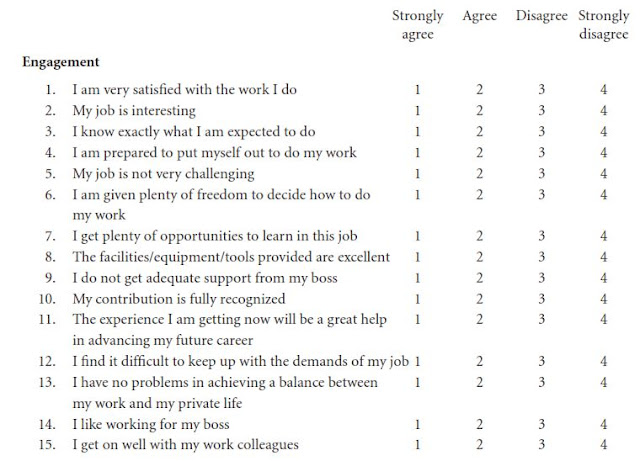The concept of Employee
Engagement has been around since the 1990s and one of its pioneers; William
Kahn defined it as “the harnessing of
organization members’ selves to their work roles; in engagement, people employ
and express themselves physically, cognitively, and emotionally during role
performances” (Kahn,1990). Albrecht (2010)
argued that a successful definition of employee engagement would identify it as
the positive state of mind of an employees’, identified by their high likelihood
of putting in discretionary efforts to drive the organization towards its goals. A common theme that many of
the researchers agree on is that the concept of employee engagement compromises
of an energy factor and an identification factor, both relating to the work
aspect of employee (Bakker and Leiter, 2010). When looked at in a boarder sense, employee
engagement also correlates to the awareness of the employee on how the business
is performing & the alignment of an employee with the organizational
objectives. Engaged employees are able to relate their job descriptions with
the objectives of the organization (CIPD, 2019; p. 1). Schaufeli and Bakker (2004) defined
engagement as a state of mind relating to positive, fulfilling work that is
characterized by three key elements; vigor,
dedication and absorption.
Vigor is
the willingness of the employees to do the “hard” work, having the
determination and the willingness to put in the time & effort that is
needed to get the difficult work done.
Dedication is the presence of significance, enthusiasm, inspiration, pride, and challenge in the employees.
Absorption how concentrated and “happily” occupied the employees are with their work, to the level where detaching from work becomes a challenge. This is the state commonly referred to as being on a “flow”, where the mind is laser focused on the job at hand & the body executes flawlessly.
Dedication is the presence of significance, enthusiasm, inspiration, pride, and challenge in the employees.
Absorption how concentrated and “happily” occupied the employees are with their work, to the level where detaching from work becomes a challenge. This is the state commonly referred to as being on a “flow”, where the mind is laser focused on the job at hand & the body executes flawlessly.
Employee satisfaction, regardless of having some similarities with employee engagement, should not be considered to be the same as employee engagement. Engagement much more than mere satisfaction. For example, even a completely disengaged employee could be satisfied with their job. A high level of Passion and a high level of commitment are two of the key characteristics of an engaged employee - these qualities cannot be measured the same way that one would measure job satisfaction (Macey and Schneider, 2008). During his speech at Stanford class of 2005 commencement ceremony, Steve Jobs said “the only way to do great work is to love what you do” (Stanford University, 2005). “Loving” what you do, could be looked at as being synonymous to an interpersonal relationship where passion and commitment are essential ingredients; much similar to the engagement of an employee to their job.
Video 01: What Is the Definition of Employee
Engagement?
Source: (Kruse, 2015)
Figure 1: Key Factors that
drive Employee Engagement and the Key Outcomes for the Individual (Employee) &
the Organization
Source: (Sundaray, 2011)
Figure 1 depicts the key
factors that trigger employee engagement (the input) and the key outcomes that
the individual (employee) and the organization (employer) can expect (the
output). It is evident that Job Satisfaction is only one of the factors that
stimulates employee engagement. The thirteen factors listed on Figure 1 makes
it clear that creating employee engagement not an overnight process and the
organization must infuse the concept in to its culture as well as other
policies and procedures. The outcomes of employee engagement will be discussed
in detail on a forthcoming post.
References:
Albrecht,
S. L. (2010). Handbook of Employee Engagement: Perspectives, Issues, Research
and Practice. 1st ed. Massachusetts: Edward Elgar Publishing Limited, pp.05-08.
Bakker, A. B. and Leiter, M. P. (2010). Work engagement. 1st ed. New York: Psychology Press, pp.05-08.
Kahn, W. A. (1990)
Psychological Conditions of Personal Engagement and Disengagement at Work. Academy of Management Journal, 33(4), pp.
692–724.
Macey W.H. and Schneider B.
(2008) The Meaning of Employee Engagement. Industrial
and Organizational Psychology, 1(1), pp. 3-30.
Kruse, K. (2015) What Is the Definition of Employee Engagement?. [Online]. Available at: https://www.youtube.com/watch?v=Uu7EG6EZeAM [Accessed on 23 October 2019].
Kruse, K. (2015) What Is the Definition of Employee Engagement?. [Online]. Available at: https://www.youtube.com/watch?v=Uu7EG6EZeAM [Accessed on 23 October 2019].
Schaufeli, W. B. and Bakker,
A. B. (2004) Job demands, job resources, and their relationship with burnout
and engagement: a multi-sample study. Journal
of Organizational Behavior, 25(1), pp. 293-315.
Stanford University (2005) 'You've
got to find what you love,' Jobs says. [Online]. Available at: https://news.stanford.edu/2005/06/14/jobs-061505/ [Accessed
on 20 October 2019].
Sundaray, B.K. (2011) Employee
Engagement: A Driver of Organizational
Effectiveness. European Journal of Business and Management.
3(8), p. 59.





